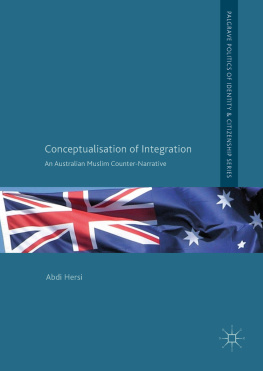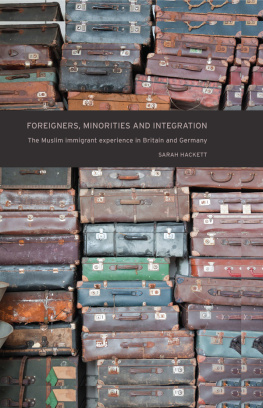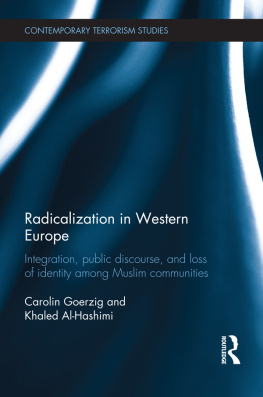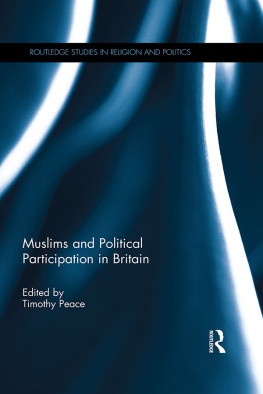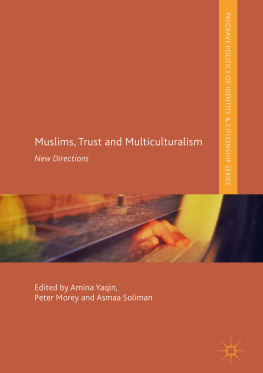1. Introduction
The integration of immigrants into their host societies continues to be a hotly debated topic around the world today. As people migrate from one place to another, they inevitably come into contact with strangers, and they are expected to, or sometimes ordered to, assimilate and become part of the wider society. However, the adopted processes and programmes to incorporate immigrants into their new societies vary. A clear definition of integration eludes researchers, governments and host communities. Immigrant incorporation is thus explained as being the most pressing policy and social challenge that liberal nation-states face (Goodman, , p. 769). The purpose of this book is, therefore, to examine the concept of integration and its meaning through the eyes of Muslims in Australia. This study departs from the focus on policy and institutional frameworks which reduces integration to a concept, and a model of incorporation adopted by a state. Instead, it attempts to initiate an approach that acknowledges that there may be variations in how different ethnic, cultural and religious groups interpret integration, and recognises that integration is a lived social experience involving complex subjective and objective levels. Research into the ways in which Muslims conceive integration, and whether or not proposed government policies of integration are cognisant with Muslims understandings, has been largely unexplored to date.
This book sets out to make a meaningful contribution to the broader scholarly debates about migrant integration, specifically within the sphere of Muslim migrant integration. The importance of addressing this gap in the literature cannot be underestimated, as this is a study of everyday social actors perceptions of core national values such as belonging and social inclusion into the nation-state. It is essential to gain an understanding of how simple everyday things are shaping feelings of social inclusion and belonging to the nation-state. The entire symbolic universe that exists in our suburbs, markets, schools and places where we come into contact with people on a routine basis orients us towards, or away from, others (Schaeffer, ).
Immigrant integration is an issue of concern to policymakers and the broader society because of its potential impact on the social harmony and cohesion of the nation (Hugo, ). Policies surrounding the integration of Muslim immigrants are high on the agendas of a number of migrant-receiving nations. A strong rationale in undertaking this book is the importance of understanding what integration means and the processes by which immigrants become integrated or not integrated into the wider society, and how that changes the host society and the individuals involved. It is important to integrate immigrants in order to create and maintain a harmonious and cohesive society.
At the core of the contemporary debates about migrant integration in Australia is the issue of Muslim integration. A number of researchers have found that Muslims in Australia face challenges relating to the wider societys perception that their integration is problematic (Celermajer, ).
This book is designed to fill a significant research gap concerning Muslim conceptualisations of integration. It uncovers an issue that remains unexplored in the literature thus far, which is how Muslims in Australia interpret the concept of integration. It specifically contests academic literature and current government policies, which advance a top-down belief about how to integrate immigrants into the wider society, with no regard for how these policies are received by the immigrants themselves, or by members of the wider society. However, in addition to its specific focus on Muslim conceptualisation of integration, this line of inquiry may set the scene for future research to shed light on the extent to which different layers of society, social institutions and groups subscribe to perhaps different and contradictory definitions of integration. The author acknowledges that a critical issue that needs to be examined is the extent to which meanings of integration are similar or different between different constituent actors in the process of integration. However, this book is limited in its scope, and it explicitly addresses Muslim conceptualisations of integration. Previous research has overlooked the extent to which communal opinions of the concept of integration, be it those of immigrants or the wider society, match with those of the state and vice versa. The author recognises this fact and understands that integration is a complex process that has multiple actors and players:
the individual immigrant who decides to migrate;
the host society that is made up of individuals and social institutions with collective values who receive these immigrants;
the state or government that makes the policy determinations and laws concerning who should migrate to that country and how they should be integrated; and
the media who arguably influences the public and political discussions of integration.
The complexity of the interactions between these various actors and their understandings of what integration means is not what this author intends to evaluate. However, this is not to say an examination is not warranted into whether or not the textual interpretations of the term integration , which bureaucrats are bound to uphold by legal writ and conduct, differ from how immigrants, including Muslims, perceive integration.
The author develops an innovative approach to examine what integration means to Muslims in Australia , employing dual methods to reach an understanding of what meanings of integration are advanced by Muslims in Australia. For example, the first study relies on a series of focus group discussions conducted with Muslims in the South East Queensland region, whereas the second study utilises in-depth interviews with members of the Muslim community in the South East Queensland region, Australia. While the first study alone provides sufficient information about what meanings Muslims assign to the term integration , the intent of this study is to go further than the definitional terms of integration and therefore employs the cognitive psychology theory of schema (Cerulo, ) to understand the research participants cognitive interpretations of the concept. The application of this cognitive psychology theory of schema lends increased credibility to the research findings and complements the findings of the thematic analysis in the focus group discussions.
Chapter Outline
Chapter explains the polarised nature of the debates about international migration, and in particular, the subject of migrant integration. As a background to the core research question of integration, it highlights international levels of migrant movement and briefly explains reasons why migrants move from one place to another.
Chapter ) data on the Australian Census of Population to provide a context to the topic currently under study.
Chapter discusses the proliferated meanings of integration in literature and the absence of any consistently agreed indicators of successful and/or unsuccessful integration. It also highlights findings of this empirical study, revealing how Muslim respondents in this study held suspicions about the concept of integration.
Chapter presents findings based on data from four focus groups conducted in Brisbane and in South East Queensland and discusses the meanings Muslim respondents assigned to the term integration . It specifically explains research findings about Muslim belief systems and practical elements of integration.

